Yesterday (1´st of March 2018) I had the honour of being part of a panel discussion at The Coastal First Nations Dance Festival in Vancouver.
I was very nervous and rewrote the manuscript for my presentation three times. I also brought it with me on stage.
But after hearing the other wonderful artist talk about they’re work I couldn´t say anything of what I had planned. I needed to talk about shame.
I have been doing dance, theatre and performing arts all my life. Ever since I forcefully directed my friends in self-made plays that we showed off to our parents when I was a child, through professional dance education, years with amateur theatre while I worked as an engineer and raced my daughters, through the time of educating as an actor and artist building up a professional career as a mature woman already too old in the eyes of society.
I discovered my roots while making a performance about being a refugee. My grandmother experienced the evacuation of northern Norway during the second world war. As the germans lost the war they burned down the entire northern Norway to the ground. Every house, every boat, all that could be eaten or used for shelter, all lifestock were killed. So was pictures, clothes and all other remnants of the history of my people. The coastal sami people. My grandmother was sent south with all other northeneers. She left her culture there and started a new life in the south as a Norwegian.
The performance I made was named “Pictures – fleeing”.
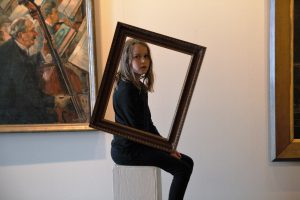
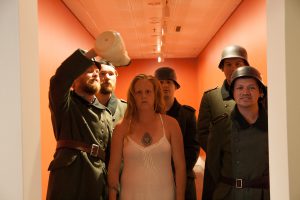
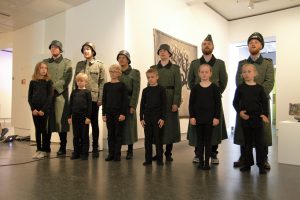
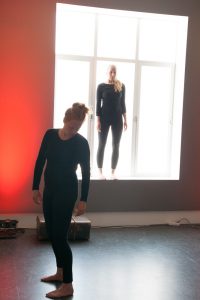
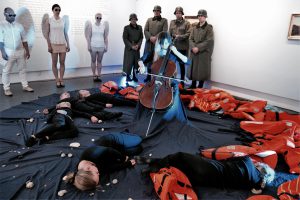
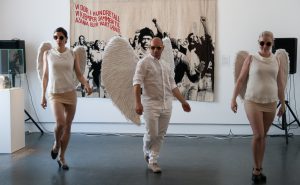
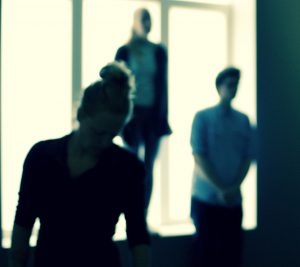
This work got me started on a search for what my grandmothers life was like before she came to Trondheim, the city I was born and grew up in. My grandmothers name is Agnethe Nikoline Margrethe Lorås Hanssen. She was almost 90 years of age before she admitted to be a coastal sami. So much shame has been forced on my people, that she had lived her entire life denying her heritage and origin.
The small place Kvalsund (meaning “whale channel”), where my grandmother was born, is known in Norwegian history books as the place in Norway where the assimilation politics where most successful.
The oppression of the sami people started more than 1000 years ago. Already in the Viking age, Viking kings put unproportionally large taxes on the sami people. The sami were clever craft makers and hunters. Their beautiful handcraft and fur was taken by the Viking kings as tax. The sami people had already been sailing the harshest waters in the world with their small boats for centuries, and were the best boat builders. They were hired by the Vikings to help building the Viking ships that was later used by the Vikings to conquer the world.
The boats the sami used are now known as the “Nordlandsbåt” (Northern country boat), and are not at all associated with the sami. The coastal sami culture is to a wide degree adapted and assmiliated into northern Norwegian culture, which makes it hard to prove that anything of value is of sami origin.
For thousands of years the sami had lived of fishing and hunting in the northern areas. The colonialization, that started by the coast and slowly continued towards the mountains, forced the sami to start herding reindeers or settle as farmers and fishermen to more effectively use the resources. This caused the split in the culture into mountain sami that hearded reindeers and coastal sami that were fishermen and farmers.
The unfear taxes of the sami people continued through centuries. At times the sami had to pay taxes to both Denmark-Norway, Sweden-Finland and Russia as the nations fought over power of these lands.
The witch-hunt in Europe in the 16´th and 17´th century led to the first and gratest destruction of the sami culture. The Danish-Norwegian King Christian IV demanded that “the wicked sourcer-people of the north must be punished by fire and death”. The witch-hunt in northern Norway was the most intense in the entire Europe when counted as percentage of population. All drums were burned and most noaidis (sami shamans) were killed. Aloong the west-coast of northern Norway a large percentage of the killed witches were men. It is lightly to believe that property conflicts might have been a crucial reason for that. After the witch-hunt the christian preasts continued their missionary activities among the sami. The traditional joik was forbidden and the sami religion was extinct.
As the colonialization continued new laws was established that clamed that if you were to own land you had to have a Norwegian name. The reindeer herders was still nomads, so they didn´t need to own land, but the coastal sami people who had settled now changed theire names to be able to own land. Thus the coastal sami lost theire traditional names. Then laws came that demanded that you needed to speak Norwegian to own land. Thus the coastal sami people made sure to have their children speak Norwegian.
In the beginning of the 19-th century it was decided that all sami children were to attend internat-schools (schools were children have to live at the school). In the school they were forbidden of speaking sami language. When my grandmother were 11 her teacher said, that from today on it is forbidden to be sami. The sami people does not exist anymore.
At the same time there were performed racial research that claimed that the sami people was not human and had less ability to learn, and thus of lesser value than the arial race.
The mountain sami that had managed to keep their traditions did not longer approve of the coastal sami. The coastal sami were now too sami to be Norwegians, but too Norwegian to be sami. There were no pride left in my people.
Then the WW2 started and the evacuation happened. All remnants of our culture was burned. The people was sent south and many chose to leave their culture behind and become Norwegians once and for all. As did my grandmother. I read somewhere that before WW2 95% of the people of the far north recognized themselves as sami or Kven (finnish immigrants) and only 5 % recognized themselves as Norwegians. But after WW2 when the rebuilding of Finnmark and Nord-Troms (northern Norway) had started, only 5% recognized themselves as sami, and 95% recognized themselves as Norwegians.
Hardly any of the sami that moved south and stayed bothered to teach their children the sami language. Thus our language was lost.
It ads to the history that the refugees during the evacuation experienced hatred from the people in the south, they were claimed to be filthy, valueless, not humans. They were bullied at school, had trouble finding jobs and places to live. They had to try to become Norwegians to be accepted in the society.
This story I have told is a story of 1000 years of shame. A shame that is so burnt into our people that we inherit it from mother to daughter through generations. We will never be good enough. It is a chain that we need to brake, and I don´t know how to brake it. I can just put words and art to it and try to pretend that I feel valuable.
My realization of this shame became my next performance: Riegadeapmi (Northern sami word for “birth”). “I was born at the age of 35” is an ongoing sentence of this performance. It is my about my own discovery of being a coastal sami, and about the shame my family is carrying. That is why I carry the drum I don´t know how to play, while I scrub the dirty floor in my finest dress, that I later cut into piezes to provide handkerchieves for the sniezy public.
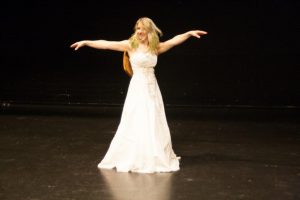
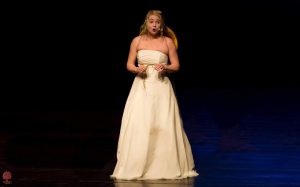
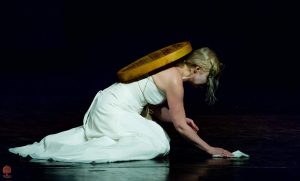
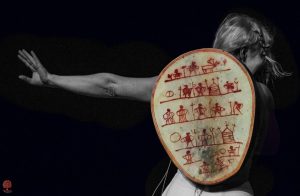
Riegadeapmi premiered at The International Arts Festival in New Delhi in 2016, and was later played at the Tråante Festival in Trondheim in 2017.
I had now worked myself through the evacuation – which almost put and end to the coastal sami culture, and through the sami history and my familys history of shame. Now I had to figure out what the coastal sami culture was really about.
This is how I started to work with “Heritage”. A theatre performance with visual dramaturgy consisting of music, dance, text, film and lighting. It was originally named “Heritage – In my grandmother’s footsteps”. I literally followed her footsteps, as I travelled to the place where she was born, and found the remnants of the house where she had lived as a child. I got to see places where witches had been burned, where the coastal sami culture once were a rich and proud one. And I suddenly realized that my grandmothers stories from my childhood was real cultural heritage that I´d never realized the exclusive value of. As was the way I had been raised by my mother who did´nt know she was raising me the sami way. I tried through the work with “Heritage” to give life to these histories and the culture I had discovered, and to express what we have been exposed to through the last centuries.
The performance premiered at Tråante 2017 and later toured in Bangladesh. We´re still touring in Norway with this performance.
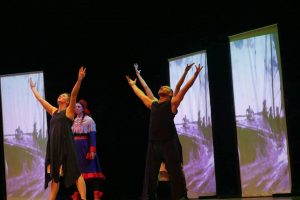
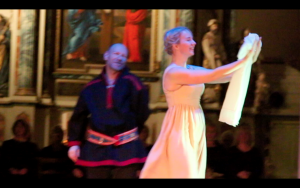
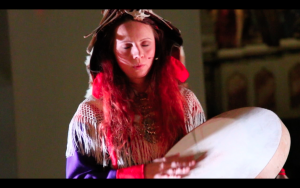
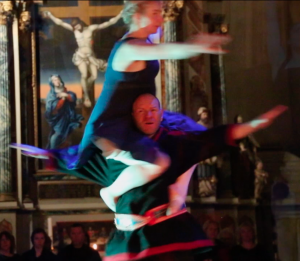
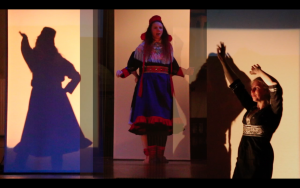
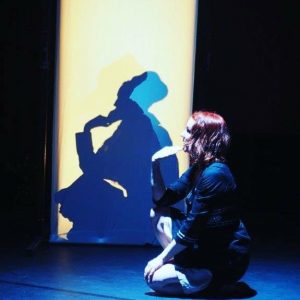
Pictures from “Heritage”.
There is also a film from this performance that can be seen on youtube: https://www.youtube.com/watch?v=1cQyx_3NAkI
It is not much left of the coastal sami culture. It needs to be reclaimed, rediscovered and rebuilt. The language must be taken back. The road seems endless. But I have started to walk that road. And I am grateful that my grandmother lived long enough to pass this knowledge on to us. She´s 95 years old and still a smart, strong and wonderful woman.
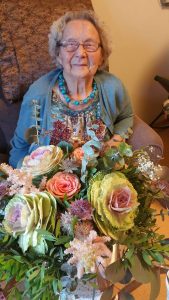
My grandmother: Agnethe Nikoline Margrethe Lorås Hanssen.
At the moment I´m working on smaller projects with the purpose of bringing the coastal sami culture out to people. This is why I´ve made “When the sun disappeared”. A childrens performance that premiered at the library in Trondheim in February 2018.
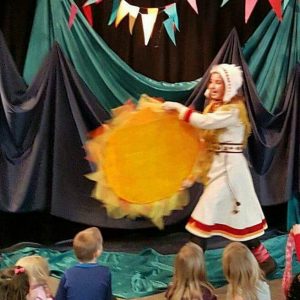
Picture from «When the sun disappeared», at Trondheim Library 24´th of February 2018.
The dance performance Sáráhkkás Tears serves the same purpose. It is a small adventure based around a teenaged coastal sami girl and her relation to the sami goddess Sáráhkká, Who lives in the fireplace and who´s aim is to protect babies and especially girls while they grow up. This is a dance performance, accompanied by text and music, that premiered at The Coastal First Nations Dance festival in Vancouver, March 2018.
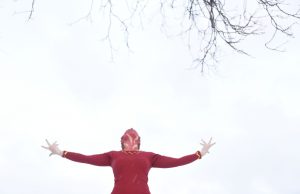
Picture from the photoshoot for Sáráhkkás Tears.
This is how far I have got on my artistic road into the sami culture. But I´m still walking. It will be interesting to see where it continues from here.
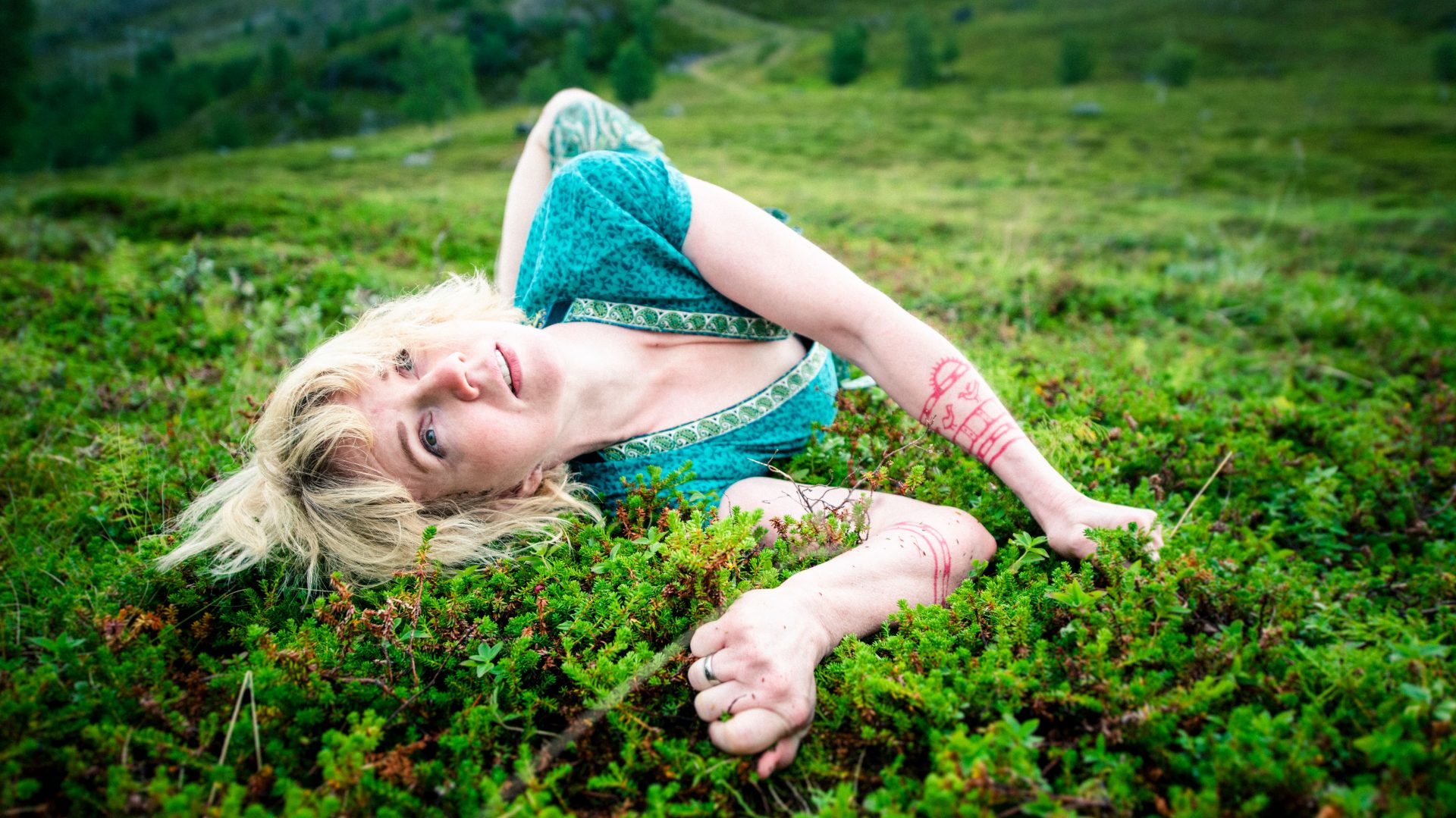
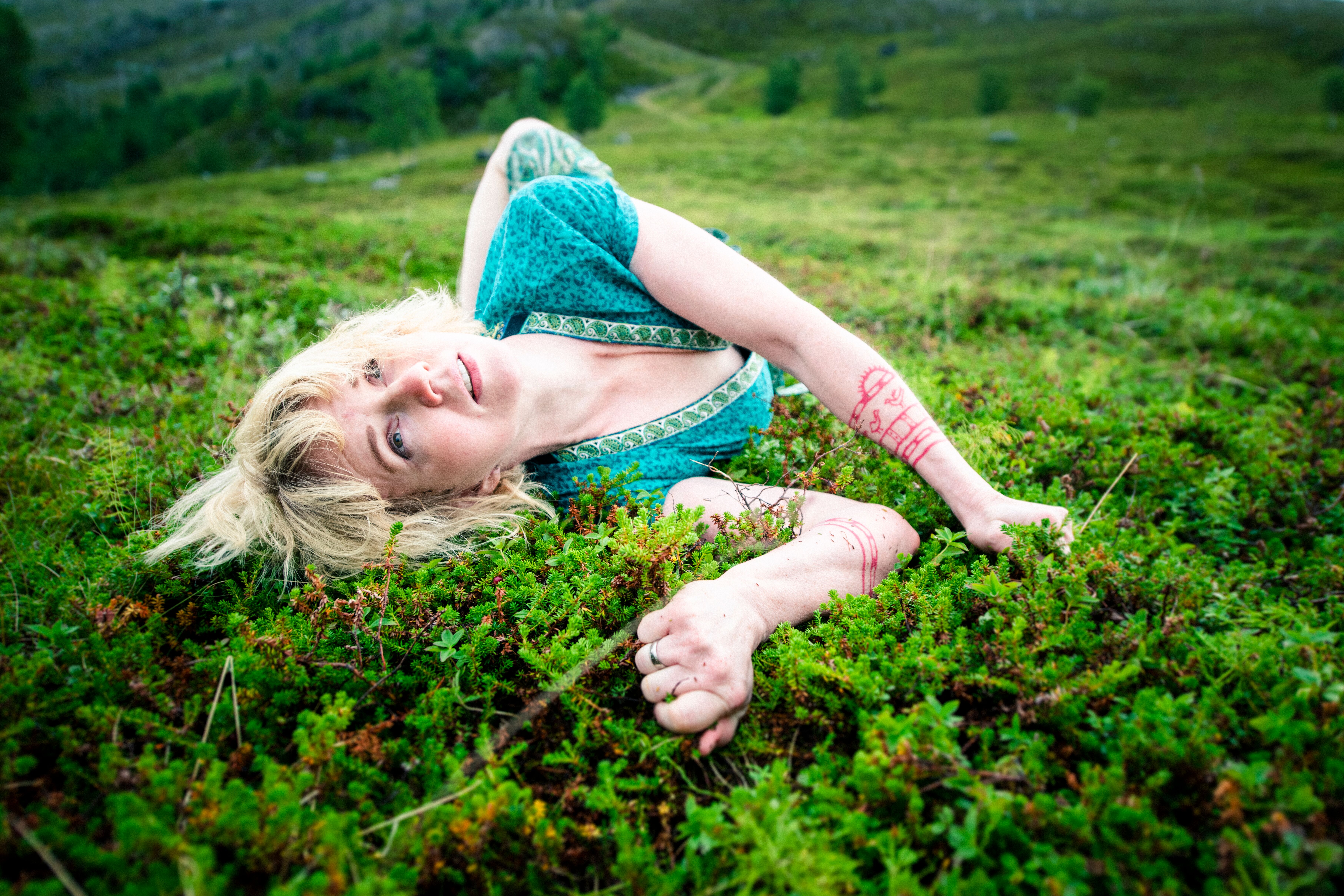
Så herlig å lese hele historien (så langt) så sammenfattet. Jeg har jo sett noen av forestillingene og fulgt med på litt av reisen. Jeg er imponert over alt du gjør og gleder meg til å følge deg videre.